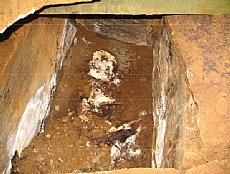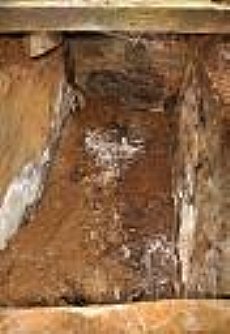Langwell Cist Burial
01 March 2020
- News Type:
- Site of the Month

In 2009 a Bronze Age cist burial was uncovered during agricultural workings near Langwall, Strath Oykel. It was immediately clear that the body was exceptionally well-preserved. Unfortunately before it was possible to do a modern excavation and maximise preservation of the organics, most of the bones and contents were removed by the police, destroying some of the remains.

© A. Puls courtesy
Highland HER
A suite of post-excavation analyses was undertaken on the cist’s contents and the surrounding area. A young woman in her late 20s had been wrapped in a brown cattle hide, and buried in a cist along with wooden and textile objects. The exceptional remains of the body were either the result of deliberate mummification or waterlogged conditions. If the former, this is rare evidence of this practice which is known from the Wester Isles at Cladh Hallam.
The body lay on its left side, with tightly flexed knees. This is different from the general pattern found for northeastern beaker burials. Radiocarbon dates show she was buried between 2200 and 1960 BC. She was probably local, and isotopic analysis shows that she had a mainly terrestrial diet, possibly with freshwater fish as well. This is a common finding for early Bronze Age people. Her teeth showed that she had dental enamel hypoplasma, a condition which could have been caused by malnutrition, anaemia or high fever.
The cattle hide was a rare survival, but there are other burials with animal skins known from Scotland. At Spinningdale in Sutherland the body either lay on or was wrapped in a sheepskin. Unfortunately most of the woven material observed when the Langwell cist was opened was destroyed by the police, and much interpretation was based on photographs. From the photographs, it appears that some kind of woven material was around the legs and skull. much of this is covered by a white deposit. Various types of analysis were made on this deposit, and it was concluded it was likely to be a product of bone recrystallisation.
Microfaunal analysis identified 13 mites in the cattle hide or cist, of the sort found on rodents. They may therefore have entered the cist as mice burrowed in, but there was no other evidence of rodent disturbance. They suggest that the hide was not tanned, and opens the possibility that the body was wrapped in a freshly butchered skin.
Other macrofaunal evidence provided evidence of the landscape around the cist. They revealed that a Scot’s pine was burned between 2470 and 2200 cal BC. Some of the carbonised heathland and grassland pollen suggests vegetation had been cleared by burning. Then several hundred years later the pit was dug and the cist made. After the top slab was put on the cist, it was sealed with sand and gravel, and probably had a cairn on top. The poorly draining soils resulted in periodic flooding, and would have maintained waterlogged conditions. A few hundred years after the burial, birch trees were felled, and then later a curved stone feature was built, perhaps as a landscape marker of some sort. At the beginning of the Iron Age, peat began to form on the floor of the river valley; it was still forming in the early Historic period.
This burial is important for several reasons. It shows the possibility of good preservation, even in areas where the soils did not lend one to suspect favourable conditions. It also is a good example of the information which can be gleaned using an array of scientific analyses, providing information on the local environment and burial conditions and practices. It also shows that burials without grave goods are not necessarily ‘poor’, but may have held a wealth of organic gravegoods which have not survived. Finally the burial hints that mummification might have been practised in the Highlands.
Further information:
Lelong, Olivia et al 2014 ‘Wrappings of power: a woman’s burial in cattle hide at Langwell Farm, Strath Oykel’, Proc Soc Antiq Scot, 144, 65-131.
Highland HER MHG51530
Site of the Month Archive
- 10/04/2021 Easter Raitts township
- 02/03/2021 Lower Slackbuie, Inverness (ASDA) Neolithic site
- 01/02/2021 Balnuaran of Clava cairns
- 04/01/2021 Wilkhouse Inn
- 02/12/2020 Spinningdale Cotton Mill
- 02/11/2020 Skibo A Canadian Forestry Camp
- 01/10/2020 WWI Detonator Store, Dalmore near Invergordon
- 03/09/2020 Mesolithic Shell Midden at Sand, Wester Ross
- 08/08/2020 Kinbeachie Neolithic settlement
- 01/07/2020 Armadale Cist Burial and Stone & Timber Complex
